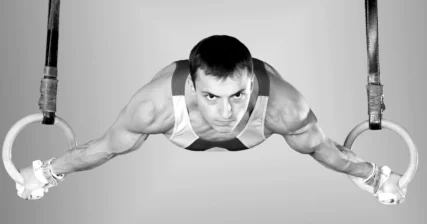Listen on: Apple Podcasts | Spotify
“Why don’t you include more cardio in your VIGOR Training workout programs?” “Isn’t cardio more important than weight training?”
I get these questions quite often. We’ve been sold the idea that aerobic exercise is best since the mid-1960s, so it’s no surprise that people are confused when they see so little cardio or endurance exercise in the mens’ and women’s fitness programs I create.
My quick response to the questions above is, “Weight training is more important than cardio.”
Of course, most people want to understand why I say that.
If you’re among those who believe cardio is the most important form of exercise, I hope the rest of this article helps you rethink that belief.
If you already understand why strength training is more important than cardio, but have had a hard time convincing others, I hope this article gives you the speaking points to pass along. Or, just share this article with those you’re trying to convince.
I realize my perspective will probably ruffle some feathers. Before you get your undies…err, running shorts in a bunch, read through the article and give it some thought.

Feel Better Fast. Guaranteed.
Energy+, EDGE, and MentaBiotics make up the Happy Juice supplement stack, with ingredients clinically proven to:
- decrease anxiousness scores by 55%
- decrease irritability scores by 60%
- decrease fatigue by 64%
- decrease anger 54%
- decrease tension by 45%
- decrease confusion by 43%
- decrease overall distress by 49%
- increase good bacteria by 70%
- decrease negative mood by 105%
- increase positive mood by 211%
Life is too short to run in the wrong direction when you don’t need to. Pun intended.
This Article Might Not Be For You
Before getting into the reasons not to do cardio, I do need to point out that this article is not suited for everyone.
This article is not intended for you if:
- You’re a competitive endurance athlete
- You love to run more than you care about your long-term health
Keep running or doing other endurance exercise. Sometimes, doing what you love is more important than doing what’s the healthiest or best for your body.
This article is intended for you if:
- Your goal is to be lean, strong, healthy, energetic
- You want to live as long as possible with the best quality-of-life
Let’s get on with it. Why is cardio not the best type of exercise for health, fitness, and longevity?
1. Cardio causes muscle loss
“Don’t lose muscle.”
That should be the first goal of any health and fitness plan. It’s even better if you can build muscle, but whatever you do, don’t lose muscle.
Muscle is your quality-of-life savings account. The less muscle you have as you enter your later years, the more likely it is you’ll die early.
Your body adapts to physical stimulus. When you run, cycle, walk on stepmills, or do other long-duration endurance activity, the signal you give your body is this: “I need to be able to move slowly for a long period of time as efficiently as possible.”
In response to the stimulus, your body starts looking for ways to lighten the load. You’d like the weight it drops to come just from fat, but it doesn’t work that way. You lose some fat and you lose some muscle.
If you’re a competitive endurance athlete, and your passion for competing is stronger than your desire to be as healthy as possible, as long as possible, keep at it.
However, if you run or ride because you think it’s “healthy” for you, the effect it has on muscle mass is reason enough to treat endurance exercise like drinking alcohol…do so sparingly.
Muscle mass affects your metabolic rate, ability to store carbohydrates, support your joints, and a whole host of other functions related to health and fitness.
Maintaining, or even building muscle into old age is the most important, controllable factor in longevity.
2. Endurance Training May Lower Thyroid
When coaching members of VIGOR Training, I try to avoid focusing on calorie-counting. It’s unnecessary for achieving a lean, healthy body.
Note: For those who want to reach single-digit body fat percentages for a physique contest or bodybuilding show, calorie-counting and macronutrient tracking may be necessary, but I’m writing for “most people” in this article. Most people would be ecstatic to no longer have their belly hanging over their belt, or to see some definition in their delts when they look in the mirror.
With all that said, I do need to talk about calorie deficit in the context of cardio or endurance exercise.
Although many people compensate for their cardio by rewarding themselves with food, and eliminate any body composition benefits they might otherwise enjoy, a large percentage of people add endurance exercise to their lifestyle, while eating the same way they always have.
In theory, adding exercise to your normal diet would create a calorie deficit, and help you lose weight. For a little while, it does. You lose some fat and you lose some muscle.
Eventually, though, your body starts to react to the calorie deficit with what’s often termed a “starvation response.”
Even though you might still be eating a considerable amount of food, if you’re burning significantly more calories than you consume, your body responds as though there is a food shortage.
This doesn’t happen in a day, or even a week. But at some point, your body thinks you’re starving, even if you’re carrying around an extra 100 pounds of body fat.
Your body reduces thyroid production, which lowers your metabolic rate.
Research shows that when you maintain your normal calorie intake, and add endurance training to your lifestyle, the caloric deficit can cause hypothyroidism.
It’s even worse for those who think a lower-calorie diet, combined with cardio is the solution for getting lean.
The larger the gap between the calories you consume, and the calories you burn, the greater the stress you put on your body.
That isn’t the worst part about low thyroid levels, though. The low thyroid also makes you feel tired and lowers your capacity for exercise, making the act of exercising even more difficult.
By the way, you can maintain a slight deficit, and safely lose body fat by eating a high-protein diet, moderating carbs, and following a good strength training program.
Not to sound like an infomercial, but “If that sounds bad, just wait! There’s more!”
3. Cardio Can Increase Cortisol
Given enough time living with the calorie deficit, cortisol levels start to rise as well.
Among its many effects, chronically high cortisol causes muscle tissue loss. Or, in our case here, more muscle tissue loss.
As your muscles shrivel up, you lose space for storing carbs. The irony is, most of the friends you run with probably tell you to fill up on carbs to fuel your runs too.
That’s a double-whammy because you end up eating more carbohydrates than normal, while simultaneously reducing your ability to store them.
In the end, most of that carb loading goes to your love handles or thighs, while the muscle on your arms and legs gets smaller and smaller.
Even worse, if you decide to stick to a calorie-restricted diet while you’re adding all that cardio, you lose muscle even faster.
Of course, the answer as I’ve already explained, isn’t to just cut back on calories and keep doing cardio. That’ll just make you skinny-fat.
You’ll look normal in jeans and a long-sleeve shirt, but underneath, your body fat percentage is still quite high and you’ve lost most of the muscle you had when you started this whole thing out.
In women, the stress of the calorie deficit can lead to amenorrhea, too.
You might associate amenorrhea with eating disorders, but excessive exercise can cause the same problems. It isn’t about too little food. It’s about living with too big a gap between what you consume, and what you burn.
4. Aerobic Exercise Isn’t Very Effective For Fat Loss
By now, this shouldn’t come as a surprise. It’s not easy to get lean when you lose muscle, suppress thyroid, and raise cortisol.
Does that happen to everyone? No. Do some people successfully get lean by doing mainly cardio? Yes.
However, not everyone who smokes regularly develops cancer, bad teeth, and yellow finger nails either. That doesn’t make cigarette smoking a good stress reliever, even though it does relieve stress.
If you don’t believe me, and decide to try it anyway, here’s what you can expect.
You’ll lose weight and feel pretty good for the first three to six weeks (assuming you haven’t run down this road before).
Around weeks four to eight, the weight loss will slow down or stop. You’ll start to feel more fatigued, even if you eat a little more. You might also get a cold or some other sickness, since the elevated cortisol compromises your immune system.
You’ll wonder why you’re no longer losing weight and why you feel so lethargic.
You might assume it’s just in your head. You might also decide to eat a little less and exercise a little more to get your weight moving again. It’ll work for two to three weeks, and then you’ll hit another plateau.
Eventually, you’ll realize there isn’t enough time in the week to exercise anymore, and life is miserable eating so little. If you don’t listen soon enough, you might end up with adrenal fatigue, or sickness more serious than a common cold.
Hopefully, you’ll remember this article and choose a better way of exercising and eating to get lean.
Even if you don’t end up in the downward spiral of a never-ending calorie deficit, you might struggle to get lean with endurance training for a few other reasons.
- You might unconsciously eat more food, especially more carbohydrate-rich food, to compensate for the energy you burn during exercise.
- If you exercise as part of a club, like a run club or cycle club, you’ll be more likely to use food and alcohol as an after-exercise reward, rather than following your training session with a steak and broccoli.
- You’ll unconsciously sit more the rest of the day. Researchers call the non-exercise energy you burn “non-exercise activity thermogenesis” (NEAT), and studies show that NEAT is lower in those who participate in high-intensity exercise.
When It’s Appropriate To Use Cardio For Fat Loss
Of course, I’m not saying that no one should ever do cardio. These are a few circumstances when I do incorporate more cardio into client’s programming.
- When you need to lose the last 10-15 pounds before you step into a wedding gown, onto a bodybuilding stage, finish a weight loss contest, or need some half-naked photos for your Instagram feed
- For women with PCOS or higher androgen levels, where they already have a significant amount of muscle mass
- In those who’ve been completely sedentary for years, and need to simply move more for a couple of months before transitioning to strength training
5. Endurance Training Can Lead To Repetitive Use Injuries
An average man running a six-minute mile takes about 1000 strides per mile. That’s about 500 landings per leg.
A five-mile run would be about 5000 strides. It’s not surprising that knee, ankle, and hip pain is common among people who run, who aren’t competitive runners.
The way you land when you run has a significant impact on how much stress your ankles, knees, and hips take with each foot strike. Most competitive runners land on their middle foot to forefoot. Inexperienced runners usually land on their heels, causing much more force to jar through their lower limbs and hips.
No matter which way you land, though, you still hit the ground with a significant force each foot fall. Walking the same distance reduces the force, but increases the number of strides. When you walk, you’re also more likely to land on your heel.
When it comes down to it, some people were built to run. Those who weren’t are more likely to get hurt. However, everyone can safely lift weights.
6. Endurance Training May Increase Inflammation
Inflammation is one of the key contributors to heart and other degenerative disease, free radical production, and other health problems. A little inflammation isn’t bad. You even cause some inflammation with strength training, which is part of the cause of delayed onset muscle soreness (DOMS).
With endurance training, the inflammation may not feel as extreme, but it can last longer.
While a 20-minute cardio session on an elliptical probably won’t increase inflammation, longer-duration endurance exercise will, even in seasoned athletes.
The repetitive pounding and muscle damage from running increases inflammation, as does the glycogen depletion caused by longer-duration aerobic exercise.
The immune system reflects the stress the body goes through during long-distance running…After every long run, the immune system is heavily occupied with repairing muscle damage. Stress hormones increase as glycogen levels decrease, contributing to transient inflammation and immune dysfunction.
David Nieman, Appalachian State University Human Performance Lab
It’s unfortunate that so many people associate running a marathon as something healthy, because it’s not. It can actually be counter to cardiovascular health.
Research shows that atherosclerotic plaque was present in the arteries of 90% of marathon runners, age 50-75 years old. In addition, carotid intimacy media thickness (cIMT), another marker of atherosclerosis, was no different in young, middle-aged, or veteran endurance athletes, nor their age-matched sedentary spouses.
Granted, these are population based studies I’m referring to. However, if endurance training really was good for your heart, you’d expect at least a little bit of superiority when it comes to the heart health of endurance athletes compared to others.
7. Endurance Training Compromises Gut Barrier Function
If you listen to avid endurance athletes, they often talk of respiratory and gut issues.
Digestive distress is all-too-common.
It seems that endurance training plus glycogen depletion wreaks havoc on gut permeability, allowing proteins to enter the circulation, and increasing the chance of developing food sensitivities or allergies.
Of course, some of the gut permeability problem can be resolved with a better diet.
8. Chronic Cardio May Lower Testosterone
Testosterone usually drops when cortisol rises, and we’ve already discussed that fact that cortisol often increases with endurance training.
There’s actually a term for this drop in testosterone associated with exercise in men.
Exercise-hypogonadal male condition: a state of long-term, low-testosterone levels caused by endurance training or by maintaining extremely low body fat levels for sports like gymnastics, wrestling, and running.
Although it’s considered a “male condition,” women are just as likely, if not more likely to experience lower testosterone. At least half of testosterone in women is made from DHEA, which is supplied by the adrenal glands.
When the adrenals have to pump out cortisol, they don’t make as much testosterone.
The effects of low testosterone include:
- Decreased protein (muscle) synthesis (building)
- Increased protein breakdown
- Suppressed bone formation
- Depressed mood
That’s no good for men or for women.
9. Endurance Training Leads To Low Bone Density
I started this list talking about the importance of muscle. While muscle mass is, in my opinion, the most modifiable risk factor in long-term health, bone density would be a second.
I mentioned this in my article on the health benefits of strength training, but it’s worth repeating again. According to the National Osteoporosis Foundation:
- A woman’s risk of fracture is equal to her combined risk of getting breast, uterine, and ovarian cancer
- Men are more likely to break a bone due to osteoporosis than to get prostate cancer
- A quarter of 50+ year old hip fracture patients die within a year of the fracture
- Six months after a hip fracture, only 15% or patients can walk across a room without assistance
Consider those statements. Then listen to this:
Current research suggests that…bone health in distance runners, cyclists, and swimmers tends to be inferior to that seen in athletes of other sports. The consequences of reduced bone accrual in young athletes and maintenance of bone mass in masters athletes include an increased rate of stress fracture and risk of fragility fractures later in life.
Scofield, K, et al.
Interestingly, the researchers in that study even found that the bone density of some of the endurance athletes was less than that of their inactive peers.
If not cardio, then what?
While some people were born with a body that’s better-suited for running, everyone can lift weights. Everyone benefits from lifting weights.
And, in my opinion, weight training should be the priority for almost everyone.
You can build and maintain muscle and bone density, get leaner, improve cardiovascular function, and much more.
I always encourage people to join a gym, but you don’t have to if one isn’t accessible or within your budget.
You need access to free weight like barbells, dumbbells, a bench and a squat rack. There’s a good chance that someone right now has everything you need for sale on Craig’s list.
When you’re ready to follow professionally-designed strength training program, join VIGOR Training.



